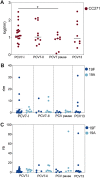Effect of pneumococcal conjugate vaccine availability on Streptococcus pneumoniae infections and genetic recombination in Zhejiang, China from 2009 to 2019
- PMID: 35135440
- PMCID: PMC8865111
- DOI: 10.1080/22221751.2022.2040921
Effect of pneumococcal conjugate vaccine availability on Streptococcus pneumoniae infections and genetic recombination in Zhejiang, China from 2009 to 2019
Abstract
Pneumococcal pneumonia is one of the main reasons for child death worldwide. Pneumococcal conjugate vaccines (PCVs) are considered the most effective strategy for pneumococcal disease (PD) prevention, but how a pause in PCV vaccination affects the prevalence of PD or the genetic evolution of Streptococcus pneumoniae genetic evolution is unknown. Based on the unique PCV introduction timeline (vaccine unavailable during April 2015-April 2017) in China, we aimed to evaluate the effect of interrupted PCV availability on PD and pneumococcal genome variation. Pneumococcal isolates (n = 386) were collected retrospectively from eight sites in Zhejiang, China from 2009 to 2019 in which 184 pathogenic (isolates from sterile and infection sites) strains were identified. An interrupted time series analysis was conducted to estimate changes in PD and the recombination frequency of whole genome-sequenced strains was estimated via SNP calling. We found that both PD and pneumococcal genome variation were affected by interrupted PCV availability. The proportion (∼70%) of vaccine-type pneumococcal LRTI (VT-LRTI) in all LRTI cases decreased to ∼30% in the later PCV7 period and rebounded to ∼70% in children once PCV7 became unavailable in April 2015 (p = 0.0007). The major clone CC271 strains showed slowed (p = 0.0293) recombination frequency (decreased from 2.82 ± 1.16-0.72 ± 0.21) upon PCV removal. Our study illustrated for the first time that VT-LRTI fluctuated upon interrupted vaccine availability in China and causing a decreased of recombination frequency of vaccine types. Promoting a nationwide continuous vaccination programme and strengthening S. pneumoniae molecular epidemiology surveillance are essential for PD prevention.
Keywords: PCV availability; Streptococcus pneumoniae; genetic variation; pneumonia; recombination.
Conflict of interest statement
No potential conflict of interest was reported by the author(s).
Figures





References
-
- Centers for Disease Control and Prevention . [cited 2021 March 13]. Available from: https://www.cdc.gov/.
-
- Bogaert D, De Groot R, Hermans PW.. Streptococcus pneumoniae colonisation: the key to pneumococcal disease. Lancet Infect Dis. 2004 Mar;4(3):144–154. - PubMed
-
- O'Brien KL, Wolfson LJ, Watt JP, et al. . Burden of disease caused by Streptococcus pneumoniae in children younger than 5 years: global estimates. Lancet. 2009 Sep 12;374(9693):893–902. - PubMed
MeSH terms
Substances
Grants and funding
LinkOut - more resources
Full Text Sources
Other Literature Sources
Medical
Miscellaneous
